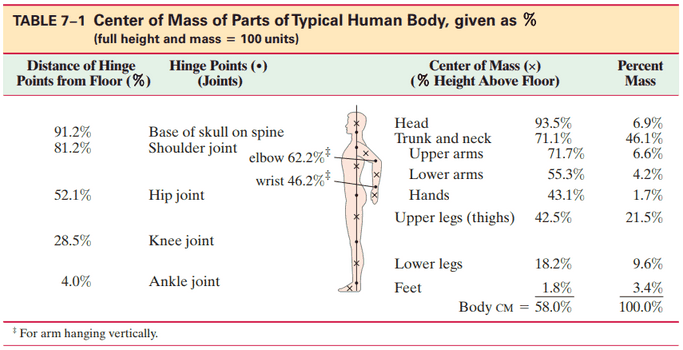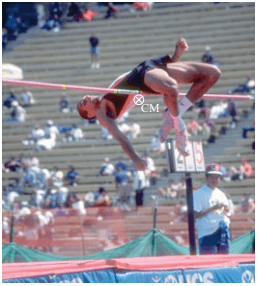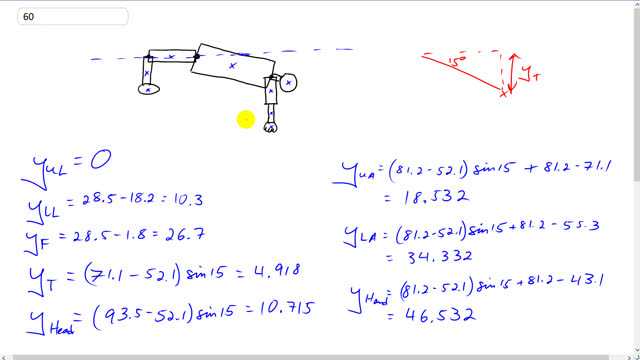
Repeat Problem 59 assuming the body bends at the hip joint by about . Estimate, using Fig. 7–27 as a model.



In order to watch this solution you need to have a subscription.
This is Giancoli Answers with Mr. Dychko. So this question is a lot of work so fasten your seat belt; we have a lot of parts of the body to consider here as we find the y-coordinate of the centre of mass of this high jumper when their torso is angled at 15 degrees about the pivot at the hip and so we need to find out the y-position of the centre of mass of the lower leg and also the foot and we are going to take this median line to be the median of the upper leg because you can't take the median line of the torso anymore since it's on this angle now. So we are gonna measure everything with respect to this horizontal line through the hips and the upper leg and we'll find the distance that the centre of mass of the torso and neck is below this horizontal line and let's do the same for the head and for the upper arm and lower arm and the hand and so on. So the y-coordinate of the centre of mass of the upper leg is nice and easy, it's 0 because that's where we defined our reference level to be and for the lower leg—it's straightforward— it's gonna be the position of the knee above the ground minus the position of the centre of mass of the lower leg above the ground plus 28.5 minus 18.2—these are percentages of total height— and that makes 10.3 And then the y-position of the foot in this picture will be the knee joint, 28.5, minus the centre of mass of the foot, 1.8, percent of the person's height above the ground and that will make 26.7 is gonna be the percent of their height below the median line to the centre of the foot. Okay. And then for the more complicated parts, let's look at the torso. Consider this triangle here and we have a right triangle where this is the hip joint and this is the centre of mass of the torso and the angle is 15 degrees we are told and our job is to figure out this vertical distance from the horizontal to the centre of mass of the torso and we know the hypotenuse of this triangle; it's gonna be the difference between the centre of mass of the torso position which is 71.1 minus the position of the hip joint which is 52.1 and then multiply that hypotenuse by sin of 15 to get the length of this opposite leg of the triangle and that gives 4.918. So this is 4.918 percent of the person's total height is the distance from the horizontal line to the centre of mass of the torso and neck. Okay and same story with the head except the hypotenuse is now 93.5 minus the hip joint position 52.1 times sin 15 to get 10.715. And then for the distance to the upper arm, well, we have the arms pointing straight down and so we'll figure out the vertical distance from the centre line to the shoulder that's gonna be the shoulder position 81.2 minus the hip position 52.1 times sin 15 gives us this height here and then add to that the distance from the shoulder to the centre of mass of the upper arm. So that's 81.2 minus 71.1—this is the centre of mass of the upper arm— and this gives 18.532 is the distance from the centre line to the centre of mass of the upper arm, 18.532. And then same type of story for the lower arm and for the hand so we have this same business here which is the distance from the median line to the shoulder— that would be this part here circled— and then take the difference between the shoulder and the lower arm or the shoulder and the hand and there we go. So we have all these distances from the horizontal mid line there to the upper arm, lower arm and hand centre of mass respectively. Then you plug into here by multiplying each of these positions by the corresponding masses. So the lower leg accounts for 9.6 percent of a person's mass times its position of 10.3 plus the mass of the foot which accounts for 3.4 percent of a person's mass times the y-position of the foot, 26.7 percent of the person's height below the median line, below the knee, and then 46.1 percent of a person's mass is in their torso times by 4.918 and then plus the mass of the head, 6.9, times its distance from the horizontal line and then mass of the upper arm, 6.6, times 18.532 and then mass of the lower arm, 4.2, times its height, 34.332, and then the mass of the hand, 1.7, times 46.532, divide by the total mass or 100 percent of their mass and you get 8.4 percent below the hip joint is gonna be the position of the y-coordinate of their centre of mass. And then we have to answer whether that's inside or outside the body so we'll take that answer and times it by 155 centimeters—typical height of a person— divide by 100 because it's a percentage there and we get about 13 centimeters which is quite far. So 13 centimeters below the hips for a typical person which is probably outside her body and so that's the other part of our answer to this question, there we go.